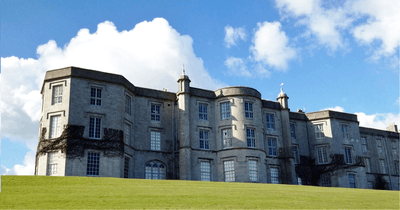Plas Newydd (Anglesey)

Plas Newydd, located in Llanfairpwllgwyngyll, Anglesey, Wales, is the country seat of the Marquess of Anglesey. The family's former principal seat at Beaudesert, Staffordshire, was sold and demolished in the 1930s.
The house is situated on the bank of the Menai Strait and has views of Snowdonia.
History
The estate can be traced to the 15th century when it was held by the Griffiths family, owners of a large estate in nearby Bangor. The estate then passed in turn to the Bagenal and Bayly families through marriage.
The house originated in the 14th century; the earliest section is the Great Hall with symmetrical entrances at either end. From there the house was expanded towards the Menai Strait and two towers were added by the Bayly family.
The building was greatly altered in the 18th century by James Wyatt who refaced it, blended the towers into the building front, and substantially made it into the building that stands today. In 1812, the estate passed to Henry William Paget, whose father had changed his surname from Bayly to Paget. Henry William was created the first Marquess of Anglesey in 1815 for his heroism at the Battle of Waterloo, where he lost a leg.[1]
At the end of the 19th century the 5th Marquess had the chapel turned into a theatre. Plays were put on regularly, with the Marquess often taking the lead role himself. After the 6th Marquess inherited the estate, all the furniture was sold to help restore the solvency of the family after the 5th Marquess' huge spending. The family also sold off their main home and their London house and moved into Plas Newydd permanently. The 6th Marquess made the final big changes to the house by removing the crenellations from the roof, disposing of the theatre, knocking three servants' rooms together to make the dining room and covering over a courtyard to provide a roof for the servants.
The house has been owned by the National Trust since 1976. There are now a tearoom and a second-hand bookshop, and historical cruises along the Menai start from the house. The first Marquess's artificial leg is part of an exhibition.
HMS Conway
In 1949 the training ship HMS Conway was moored in the Menai Straits near Plas Newydd. The ship was supported from the small dock in the grounds of the estate. Following the loss of the ship in 1953, the school built temporary facilities in the grounds near the current reception centre. These were used for teaching and housing the senior cadets. The younger cadets were accommodated in the eastern wing of the house. The former stables building was used for teacher accommodation, classrooms and a laboratory. These arrangements continued until 1964 when the entire school moved into a new purpose-built building in the grounds of the estate. The school was closed in 1974 although the school's building still stands.
Points of interest
The house contains Rex Whistler’s largest painting, measuring 58 by 12 feet (17.7 by 3.7 m).
The 7th Marquess of Anglesey retained rooms at the house until his death in July 2013.[2] Lady Rose McLaren grew up at the house along with the 7th Marquess - her brother. The 8th Marquess no longer lives at the house.
At the house there is also a Military Museum which contains campaign relics belonging to the 1st Marquess of Anglesey, mementos of the Battle of Waterloo and the Anglesey Leg.
In January 2010, the grounds became the first part of North Wales to be included in Google Street View, thanks to a scheme to include National Trust properties by using the Google Trike where vehicular access is limited.[3]
The National Trust has invested £600,000 for a marine source heat pump for the house.[4][5][6] At 300 kilowatts, the pump is to be the biggest in Britain.[5] Its oil-fired boiler made the mansion the most polluting[4] and biggest oil consumer[5] of the National Trust's properties;[4] the renovation is expected to save around £40,000 a year in operating costs.[4] Plas Newydd is one of five properties in a pilot experiment;[4][5] if they succeed, the National Trust will invest in 43 more renewable energy plans.[4][5] The pilot programme includes: biomass in Croft Castle in Herefordshire, a woodchip boiler in Ickworth in Suffolk, and hydroelectric projects in Hafod y Porth near Craflwyn in Snowdonia,[7] and at in Stickle Ghyll in the Lake District.[4][5]
References
- ↑ "Plas Newydd, Anglesey, UK". BBC. Retrieved 7 August 1014.
- ↑ The Telegraph- Obituary of The 7th Marquis of Anglesey
- ↑ National Trust sites
- ↑ 4.0 4.1 4.2 4.3 4.4 4.5 4.6 Plas Newydd: Heat from the sea to warm historic house, Roger Harrabin BBC environment analyst
- ↑ 5.0 5.1 5.2 5.3 5.4 5.5 Ocean to provide green heat source for 300-year-old mansion in Wales -The Guardian
- ↑ Country stately home to be heated by sea water The Telegraph
- ↑ Snowdonia Planning and Access Committee 11 December 2013, Snowdonia National Park Authority















